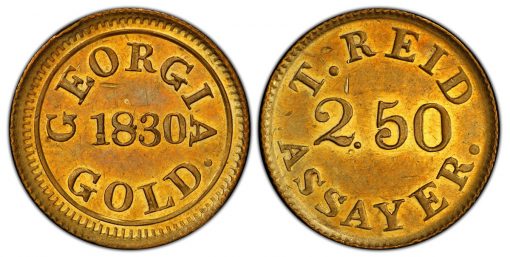Manufacturing errors might be annoying when it comes to most products, but they are a big moneymaker when it comes to collectibles. Errors increase the value of collectibles because a limited number go into circulation before the error is spotted and corrected. For evidence, look no further than a 1999 Georgia quarter whose value has been estimated as high as $10,000 due to errors.

Georgia state quarters from 1999 have several types of errors, according to the U.S. Coins Guide website. The biggest error involves coins struck on experimental metals, called planchets, intended for the Sacagawea dollar.
As U.S. Coins Guide noted, the Georgia and other state quarters were minted in 1999 when the U.S. Treasury first began the state quarters program. This took place just as the U.S. Mint was working on a new metal alloy for coins. The alloy had a gold tint that was eventually used for the one-dollar Sacagawea coins that came out in 2000.
For You: Barber Coins Are Worth Thousands: Here’s How To Spot Them in Your Spare Change
“Curious how the alloy would look on quarters, a bunch of Georgia state ones were minted using it,” the U.S. Coins Guide said in a blog. “The Treasury decided not to go with the alloy on quarters, but the ones minted with it were still released and are now very much desired by collectors.”
Some Georgia quarters struck on experimental planchets sold for as much as $10,000, according to the blog. Another sold for $7,200 in late 2022.
Here are some signs that you might have an experimental planchet 1999 Georgia quarter error:
- Weighs between 5.9 and 6.3 grams on a coin scale, which is more than the 5.67 grams for a typical copper-nickel clad quarter
- Appears thicker than normal
- Has a golden or greenish color, similar to Sacagawea dollars
- Lacks the copper (orange-colored) stripe on the edge of the coin
- Lacks some or all of the edge reeding (e.g. ridges)
- Has a thicker rim than normal (a coin’s rim refers to the raised ridge encircling the circumference of the obverse and reverse of a coin, according to Professional Coin Grading Services)
If you think you might have one of these Georgia quarters — don’t spend it. U.S. Coins Guide recommended showing it to a reputable coin dealer or getting it certified by a third-party coin grading company.
If you do end up with a rare 1999 Georgia quarter and want to sell it, the easiest way to do so is by listing it on eBay, according to the iHeart website.





Hi there, So I was given my grandmothers coin collection back it 2012. I stumbled upon one of your videos on rare quarters. I have quite a collection so I’m learning. But what I wanted to share with you is that I have this card that’s a tribute to Washington. It has a stamp with Washington and has two mint condition 1964 quarters. one from Philadelphia and the other Denver. How can I go about getting coins graded? I can send you a photo of later in an email. Thanks for your time, as well as all your tips and information in your videos.
What a wonderful collection to be given! What a cool grandmother! As far as the grading, I like using PCGS for grading. They are one of he largest and most reputable.